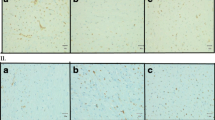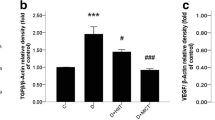Abstract
Arteriogenesis is a main defense mechanism to prevent heart and local tissues dysfunction in occlusive artery disease. TGF-β and angiostatin have a pivotal role in arteriogenesis. We tested the hypothesis that aerobic training and l-arginine supplementation promotes cardiac and skeletal muscles arteriogenesis after myocardial infarction (MI) parallel to upregulation of TGF-β and downregulation of angiostatin. For this purpose, 4 weeks after LAD occlusion, 50 male Wistar rats were randomly distributed into five groups: (1) sham surgery without MI (sham, n = 10), (2) control-MI (Con-MI, n = 10), (3) l-arginine-MI (La-MI, n = 10), (4) exercise training-MI (Ex-MI, n = 10), and (5) exercise and l-arginine-MI (Ex + La-MI). Exercise training groups running on a treadmill for 10 weeks with moderate intensity. Rats in the l-arginine-treated groups drank water containing 4 % l-arginine. Arteriolar density with different diameters (11–25, 26–50, 51–75, and 76–150 μm), TGF-β, and angiostatin gene expression were measured in cardiac (area at risk) and skeletal (soleus and gastrocnemius) muscles. Smaller arterioles decreased in cardiac after MI. Aerobic training and l-arginine increased the number of cardiac arterioles with 11–25 and 26–50 μm diameters parallel to TGF-β overexpression. In gastrocnemius muscle, the number of arterioles/mm2 was only increased in the 11 to 25 μm in response to training with and without l-arginine parallel to angiostatin downregulation. Soleus arteriolar density with different size was not different between experimental groups. Results showed that 10 weeks aerobic exercise training and l-arginine supplementation promotes arteriogenesis of heart and gastrocnemius muscles parallel to overexpression of TGF-β and downregulation of angiostatin in MI rats.




Similar content being viewed by others
References
Araki S, Izumiya Y, Hanatani S, Rokutanda T, Usuku H, Akasaki Y, Takeo T, Nakagata N, Walsh K, Ogawa H (2012) Akt1–mediated skeletal muscle growth attenuates cardiac dysfunction and remodeling after experimental myocardial infarction. Circ Heart Fail 5:116–125
Bai R, Liu W, Zhao A, Zhao Z, Jiang D Nitric oxide content and apoptosis rate in steroid-induced avascular necrosis of the femoral head. Exp Ther Med 10:591–597
Bansal A, Dai Q, Chiao YA, Hakala KW, Zhang JQ, Weintraub ST, Lindsey ML (2010) Proteomic analysis reveals late exercise effects on cardiac remodeling following myocardial infarction. J Proteomics 73:2041–2049
Batista M, Rosa J, Lopes R, Lira F, Martins E, Yamashita A, Brum P, Lancha A, Lopes A, Seelaender M (2010) Exercise training changes IL-10/TNF-α ratio in the skeletal muscle of post-MI rats. Cytokine 49:102–108
Bir SC, Pattillo CB, Pardue S, Kolluru GK, Docherty J, Goyette D, Dvorsky P, Kevil CG (2012) Nitrite anion stimulates ischemic arteriogenesis involving NO metabolism. Am J Physiol Heart Circ Physiol 303:178–188
Boroujerdi A, Welser-Alves JV, Tigges U, Milner R (2012) Chronic cerebral hypoxia promotes arteriogenic remodeling events that can be identified by reduced endoglin (CD105) expression and a switch in β1 integrins. J Cereb Blood Flow Metab 32:1820–1830
Chantrain CF, Henriet P, Jodele S, Emonard H, Feron O, Courtoy PJ, DeClerck YA, Marbaix E (2006) Mechanisms of pericyte recruitment in tumour angiogenesis: a new role for metalloproteinases. Eur J Cancer 42:310–318
Cherwek DH, Hopkins MB, Thompson MJ, Annex BH, Taylor DA (2000) Fiber type-specific differential expression of angiogenic factors in response to chronic hindlimb ischemia. Am J Physiol Heart Circ Physiol 279:932–938
Cooke JP, Losordo DW (2002) Nitric oxide and angiogenesis. Circulation 105:2133–2135
Dedkov EI, Oak K, Christensen LP, Tomanek RJ (2014) Coronary vessels and cardiac myocytes of middle-aged rats demonstrate regional sex-specific adaptation in response to postmyocardial infarction remodeling. Biol Sex Differ 5:1–14
Grundmann S, van Royen N, Pasterkamp G, Gonzalez N, Tijsma EJ, Piek JJ, Hoefer IE (2007) A new Intra-Arterial DeliveryPlatform for Pro-Arteriogenic compounds to stimulate collateral artery growth via transforming growth Factor-β1 release. J Am Coll Cardiol 50:351–358
Hazarika S, Angelo M, Li Y, Aldrich AJ, Odronic SI, Yan Z, Stamler JS, Annex BH (2008) Myocyte specific overexpression of myoglobin impairs angiogenesis after hind-limb ischemia. Arterioscler Thromb Vasc Biol 28:2144–2150
Heuslein JL, Meisner JK, Li X, Song J, Vincentelli H, Leiphart RJ, Ames EG, Blackman BR, Price RJ (2015) Mechanisms of amplified arteriogenesis in collateral artery segments exposed to reversed flow direction. Arterioscler Thromb Vasc Biol 35:2354–2365
Hudlická O, Brown MD, Silgram H (2000) Inhibition of capillary growth in chronically stimulated rat muscles by N G-nitro-l-arginine, nitric oxide synthase inhibitor. Microvasc Res 59:45–51
Laughlin MH, Cook JD, Tremble R, Ingram D, Colleran PN, Turk JR (2006) Exercise training produces nonuniform increases in arteriolar density of rat soleus and gastrocnemius muscle. Microcirculation 13:175–186
Leosco D, Rengo G, Iaccarino G, Golino L, Marchese M, Fortunato F, Zincarelli C, Sanzari E, Ciccarelli M, Galasso G (2007) Exercise promotes angiogenesis and improves β-adrenergic receptor signalling in the post-ischaemic failing rat heart. Cardiovasc Res 78:385–94
Lloyd PG, Prior BM, Li H, Yang HT, Terjung RL (2005) VEGF receptor antagonism blocks arteriogenesis, but only partially inhibits angiogenesis, in skeletal muscle of exercise-trained rats. Am J Physiol Heart Circ Physiol 288:759–768
Matsunaga T, Weihrauch DW, Moniz MC, Tessmer J, Warltier DC, Chilian WM (2002) Angiostatin inhibits coronary angiogenesis during impaired production of nitric oxide. Circulation 105:2185–2191
Miquerol L, Thireau J, Bideaux P, Sturny R, Richard S, Kelly RG (2015) Endothelial plasticity drives arterial remodeling within the endocardium after myocardial infarction. Circ Res 116:1765–1771
Negishi M, Lu D, Zhang Y-Q, Sawada Y, Sasaki T, Kayo T, Ando J, Izumi T, Kurabayashi M, Kojima I (2001) Upregulatory expression of furin and transforming growth factor-β by fluid shear stress in vascular endothelial cells. Arterioscler Thromb Vasc Biol 21:785–790
Nyberg P, Xie L, Kalluri R (2005) Endogenous inhibitors of angiogenesis. Cancer Res 65:3967–3979
Ogoh S, Hirai T, Nohara R, Taguchi S (2001) Adaptation in properties of skeletal muscle to coronary artery occlusion/reperfusion in rats. Nihon Seirigaku Zasshi 64:225–236
Persson AB, Buschmann E, Lindhorst R, Troidl K, Langhoff R, Schulte K, Buschmann I (2011) Therapeutic arteriogenesis in peripheral arterial disease: combining intervention and passive training. VASA 40:177–187
Price RJ, Owens GK, Skalak TC (1994) Immunohistochemical identification of arteriolar development using markers of smooth muscle differentiation. Evidence that capillary arterialization proceeds from terminal arterioles. Circ Res 75:520–527
Price RJ, Skalak TC (1996) Chronic ∼ 1-adrenergic blockade stimulates terminal and arcade arteriolar development. Am J Physiol 271:752–759
Prior BM, Yang H, Terjung RL (2004) What makes vessels grow with exercise training? J Appl Physiol 97:1119–1128
Ranjbar K, Nazem F, Nazari A (2015) Effect of exercise training and l-arginine on oxidative stress and left ventricular function in the post-ischemic failing rat heart. Cardiovasc Toxicol 12:1–8
Ratajczak-Wrona W, Jablonska E, Antonowicz B, Dziemianczyk D, Grabowska SZ (2013) Levels of biological markers of nitric oxide in serum of patients with squamous cell carcinoma of the oral cavity. Int J Oral Sci 5:141–145
Seghers L, Vries MR, Pardali E, Hoefer IE, Hierck BP, Dijke P, Goumans MJ, Quax PH (2012) Shear induced collateral artery growth modulated by endoglin but not by ALK1. J Cell Mol Med 16:2440–2450
Strauch AR (2003) Building better blood vessels: new insight on the molecular control of arteriogenesis. Cardiovasc Res 59:532–533
Suzuki J (2005) Microvascular angioadaptation after endurance training with l‐arginine supplementation in rat heart and hindleg muscles. Exp Physiol 90:763–771
Thomas DP, Hudlicka O, Brown MD, Deveci D (1998) Alterations in small arterioles precede changes in limb skeletal muscle after myocardial infarction. Am J Physiol Heart Circ Physiol 275:1032–1039
Tsai S, Hollenbeck ST, Ryer EJ, Edlin R, Yamanouchi D, Kundi R, Wang C, Liu B, Kent KC (2009) TGF-β through Smad3 signaling stimulates vascular smooth muscle cell proliferation and neointimal formation. Am J Physiol Heart Circ Physiol 297:540–549
van Royen N, Hoefer I, Buschmann I, Heil M, Kostin S, Deindl E, Vogel S, Korff T, Augustin H, Bode C (2002) Exogenous application of transforming growth factor beta 1 stimulates arteriogenesis in the peripheral circulation. FASEB J 16:432–434
Vara DS, Punshon G, Sales KM, Hamilton G, Seifalian AM (2006) The effect of shear stress on human endothelial cells seeded on cylindrical viscoelastic conduits: an investigation of gene expression. Biotechnol Appl Biochem 45:119–130
Wajih N, Sane DC (2003) Angiostatin selectively inhibits signaling by hepatocyte growth factor in endothelial and smooth muscle cells. Blood 101:1857–1863
Walter JJ, Sane DC (1999) Angiostatin binds to smooth muscle cells in the coronary artery and inhibits smooth muscle cell proliferation and migration in vitro. Arterioscler Thromb Vasc Biol 19:2041–2048
White FC, Bloor CM, McKirnan MD, Carroll SM (1998) Exercise training in swine promotes growth of arteriolar bed and capillary angiogenesis in heart. J Appl Physiol 85:1160–1168
Xu X, Wan W, Powers AS, Li J, Ji LL, Lao S, Wilson B, Erikson JM, Zhang JQ (2008) Effects of exercise training on cardiac function and myocardial remodeling in post myocardial infarction rats. J Mol Cell Cardiol 44:114–122
Acknowledgments
This work was supported by the national elite foundation, Tehran, Iran.
Author information
Authors and Affiliations
Corresponding author
Ethics declarations
Animals used in these experiments were treated in accordance with National Institutes of Health Guide for the Care and Use of Laboratory Animals, and the study protocols were approved by the Institutional Animal Care and Use Committee at Lorestan University of Medical Science.
Conflict of interest
The authors declare that they have no conflict of interest.
Rights and permissions
About this article
Cite this article
Ranjbar, K., Rahmani-Nia, F. & Shahabpour, E. Aerobic training and l-arginine supplementation promotes rat heart and hindleg muscles arteriogenesis after myocardial infarction. J Physiol Biochem 72, 393–404 (2016). https://doi.org/10.1007/s13105-016-0480-x
Received:
Accepted:
Published:
Issue Date:
DOI: https://doi.org/10.1007/s13105-016-0480-x




